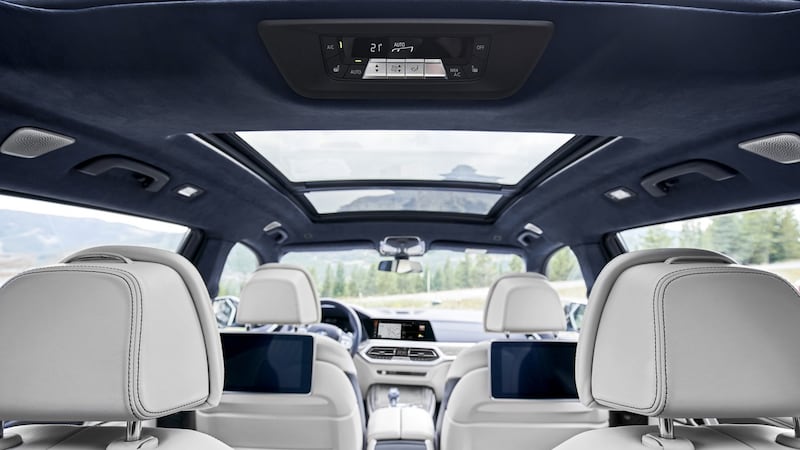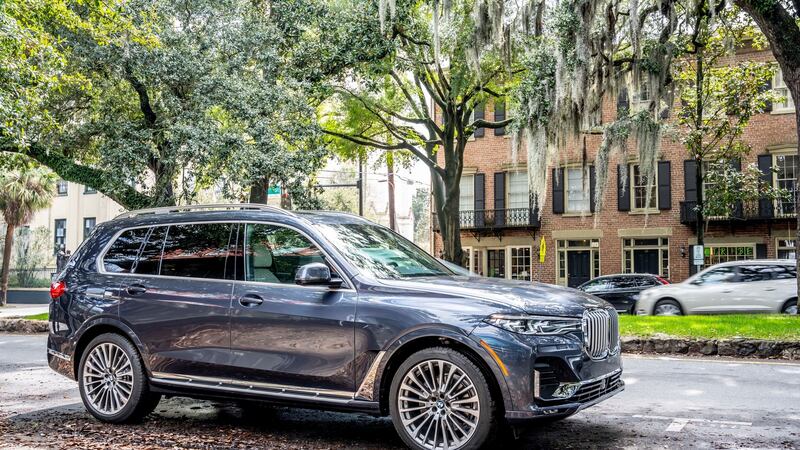When it comes to size, scale is everything. So when BMW’s new X7 seems big on the streets of the supersized US, you know they’ve built a behemoth. God only knows what this giant will look like on the streets of Galway.
This is BMW’s new flagship, the latest and largest model in its class, and at a time when even the CEOs are opting for the back seats of SUVs over long-wheelbased limos, it’s a smart addition to the ranks.
It big, though. You’ve probably guessed as much from first impressions of the X7’s front grille: it’s like someone strapped two garden gates to the front of the car.
The X7 may have Bavarian blood but it hails from the US state of South Carolina, where pick-ups roam the roads. When we hailed an Uber our driver arrived slouched behind the wheel of a Ford F150 pick-up, supping from a gallon jar of cola.
The Germanic sounding Spartanburg is where the X7 is being built, and a fitting starting point to a cross-country relay road trip for the new car that will end up in Palm Springs, California.
At a time when President Donald Trump is threatening auto tariffs against European imports, it offers a timely reminder of the globalised nature of the auto industry. It's not as simple as Europe versus the US.
Spartanburg is home to the X range, and is now BMW’s largest production facility in the world by volume, with 1,400 vehicles driving off the line each day, comprising the X3, X4, X5, X6 and now X7.
Last year it produced 356,749 vehicles, and employs over 70,000 in the region, directly and indirectly. Trump’s simplistic approach to trade tariffs could deliver an unintended sucker punch to South Carolina.
First leg
Our role in the relay is to take the spanking new X7 on the first leg from Spartanburg to Savannah, Georgia. Once you stop spooking over the size of that grille, the car's profile is relatively formulaic, rather boxy, SUV. It's actually on the same scale as its arch-rival the Range Rover. It means there are seven proper seats inside (you can opt for six if you want added comfort for middle-row passengers).

For the first 100 miles I opt for the third row, sitting on the rear axle. This is where BMW’s claims of executive comfort will really come into play. Getting in and out is as easy/difficult as its rivals, though the standard fit air suspension means the car can be lowered to reduce the climb.
The real plus is that the two third-row seats aren’t glorified folding deckchairs. These are proper leather seats, with their own air-con zone and the sort of legroom you get in a decent family hatchback.
They also benefit from a slightly raised floor, which means you get a clear view out the windscreen over the heads of the occupants in front. And the headroom is enough for your average adult.
Combined with some smart work by engineers on the air suspension, it means you can travel long distances back there in the boot of the new X7 and you won’t need a lengthy session with a physio when you get out.

Move into the middle row and you are talking about space on a par with BMW’s flagship saloon the 7 Series. It’s a similar story up at the very front.
Suspension
Taking the wheel for the latter part of our trip, the X7’s most surprising trait is that it handles and feels like a much smaller SUV, at least in the wide lanes of a US highway and on Savannah’s wide streets.
For all the promises to Make America Great Again, a good starting point would be on its roads, which remain rutted and potholed. But they prove a good test-bed for the X7's suspension, especially considering this BMW is shod with massive 21-inch or 22-inch alloys. The decision to make air suspension as standard is a sensible move for a car of this size, and for the type of customers it is pitching to win.
The most annoying trait of the X7 is its boot. The problem is common with all seven-seaters these days, but it’s bizarre that such a big car offering seven seats doesn’t provide a decent boot when all the seats are in use.
Fill the car with people and the boot offers 362 litres, most of it vertical. It's a Ryanair approach to road travel: seven travellers are welcome so long as they only have small soft carry-on hand luggage. The problem is not unique to BMW; every car company is guilty of this space sin.

Luxury market
At the very top of the executive crop, where presidents and CEOs are catered for, the BMW 7 Series has always been something of an also-ran in a market dominated by the Mercedes-Benz S-Class. This luxury market is not immune to the SUV craze, however, and this behemoth BMW offers an ideal opportunity for the Bavarian brand to bypass Mercedes.
Certainly the X7 has the beating of Mercedes’ entrant in this segment, the GLS. Several times we came across the Merc SUV on our trip, and compared to the X7 it looks drab and van-like.
Of the rest of its rivals, the Range Rover is arguably the chief competitor for status, and the Volvo XC90 for family functionality. The X7 has nothing to fear from either of these on the road at least.
We never got to take it mud-plugging, but I suspect the Range Rover has it beaten in this regard. But then this is really not meant for that sort of role, regardless of its rugged looks. Its natural habitat is outside five-star hotels.
Irish buyers may baulk at this big BMW the first time they see it, towering over traffic on Irish streets, but for the well-heeled who can afford over €113,000 for their seven-seat family car, this X7 ticks a lot of boxes. It’s striking, smart, loaded with high-end standard fare, easy to drive and relatively spacious. On the streets of Savannah, BMW’s attempt to supersize seems a surprising success.
Lowdown: BMW X7
Engine: 3-litre petrol with 340bhp or 3-litre diesel with either 265bhp or 400bhp
Fuel economy (30d version): 6.8 l/100km (41.5 mpg)
Emissions (30d version): 178g/km
0-100km/h (30d version): 7 seconds
Prices: From €113,000 for 30d; €120,890 for 40i; €137,300 for M50d
Our rating: 4/5
Verdict: Suprsized BMW has the power to surprise
















